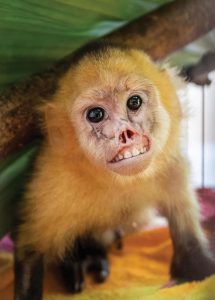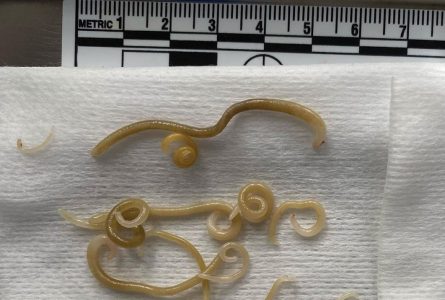Emerging Parasite Poses a Great Threat to Costa Rican Primates
 Parasitic infections have emerged as a significant contributing factor to the alarming decline in wildlife populations, particularly in light of the escalating frequency of interactions between animals and humans. Human practices, such as deforestation for agriculture, expansion of tourism infrastructure, landscape changes, and urbanisation, have led to the fragmentation of forests and the subsequent spread of parasites from wildlife to humans and domestic animals worldwide. This global phenomenon has had a detrimental impact on primate populations in Costa Rica, posing a grave threat to their health and possibly altering the transmission dynamics of parasites within these vulnerable hosts.
Parasitic infections have emerged as a significant contributing factor to the alarming decline in wildlife populations, particularly in light of the escalating frequency of interactions between animals and humans. Human practices, such as deforestation for agriculture, expansion of tourism infrastructure, landscape changes, and urbanisation, have led to the fragmentation of forests and the subsequent spread of parasites from wildlife to humans and domestic animals worldwide. This global phenomenon has had a detrimental impact on primate populations in Costa Rica, posing a grave threat to their health and possibly altering the transmission dynamics of parasites within these vulnerable hosts.
 Habitat fragmentation, accelerated by human activities, increases the chances for wildlife to come into contact with parasites. Factors such as how animals interact with others of the same species (intraspecific associations) and how they interact with different species (interspecific associations) affect the spread and impact of parasites. For example, when animals live in smaller or more isolated groups due to habitat fragmentation, it can change how parasites are transmitted between them. Understanding these interactions is crucial for addressing the risks parasites pose to primate populations and their conservation.
Habitat fragmentation, accelerated by human activities, increases the chances for wildlife to come into contact with parasites. Factors such as how animals interact with others of the same species (intraspecific associations) and how they interact with different species (interspecific associations) affect the spread and impact of parasites. For example, when animals live in smaller or more isolated groups due to habitat fragmentation, it can change how parasites are transmitted between them. Understanding these interactions is crucial for addressing the risks parasites pose to primate populations and their conservation.
In recent years, a specific parasite, Prosthenorchis elegans, has emerged as a notable concern, affecting conservation efforts to preserve Costa Rican primates. This article delves into the implications of this emerging parasite and the efforts Kids Saving the Rainforest (KSTR) is making to combat its devastating impact.
The Rise of Prosthenorchis elegans
KSTR has observed a disturbing rise in the number of cases involving squirrel and capuchin monkeys afflicted with the parasite P. elegans. In 2023, a staggering 36.7% of the primates received by KSTR tested positive for this parasite, and more than one third of those infected individuals died as a result. This intestinal parasite is spread when monkeys eat insects, such as cockroaches and beetles. Based on observations made by our team of biologists and veterinarians, KSTR believes that inadequate waste management in local communities, worsened by the growth in tourism and urbanisation in Quepos and Manuel Antonio, has created a breeding ground for cockroaches infected with this parasite. As a result, P. elegans has become more concentrated in a smaller number of host species, leading to more severe health issues in these infected individuals.
Primate Species Affected
P. elegans poses a significant challenge to several primate species, including the endangered squirrel monkeys and mantled howler monkeys, as well as the vulnerable capuchin monkeys, all of which are listed on the IUCN Red List of Threatened Species. These primates already face threats from agriculture, wildlife trafficking, conflicts with domestic animals, and electrocutions. The emergence of P. elegans adds an additional threat to their long-term survival. Moreover, this parasite has also been identified in a number of other American primate species including the Golden Lion Tamarin and the Wied’s Marmoset. The presence of P. elegans in these diverse primate species highlights the wide-ranging impact of the parasite and the need for comprehensive monitoring and conservation efforts to protect these vulnerable populations.
Impact on Conservation Efforts
The impact of P. elegans on conservation efforts is substantial. Researchers have identified P. elegans as one of the primary causes of mortality in neotropical primates within rescue centres. The parasites’ ability to severely compromise the nutrition and health of infected animals weakens them and makes them more vulnerable to additional threats such as predation or secondary infections. Consequently, this parasite poses a significant potential threat to the conservation of Costa Rican primates.
 Detection and Treatment Challenges
Detection and Treatment Challenges
Microscopic detection of P. elegans eggs in faeces is the primary method of identification. However, there are limitations to this method because P. elegans closely resembles other species in the same group. Accurately identifying P. elegans requires examining parasites during post-mortem examinations of affected animals. Unfortunately, as of yet the adult form of P. elegans shows limited response to available medications. Primates with a high number of parasites and severe symptoms often need surgery to treat intestinal damage and remove adult parasites. Recently, KSTR performed a successful surgery on white-faced capuchin, removing no less than 85 parasites from its intestine. However, surgery often has a low success rate and may not be effective against the small, hard-to-find juvenile parasites. That’s why it is crucial to conduct more research on how this parasite causes disease. Understanding its mechanisms will help develop effective treatments that can combat P. elegans and improve the chances of successful therapy for affected primates.
KSTR’s Efforts to Combat the Threat
In an effort to mitigate the conservation threat posed by P. elegans, KSTR has initiated a comprehensive study involving local and international scientists. The study aims to investigate the potential causes of the disease in primates and the observed increase in cases. Researchers will explore the various factors that potentially contribute to the development and progression of this disease, including the role of primates as the definitive hosts, intermediate hosts (cockroaches and beetles), and environmental factors such as like human activities. Additionally, KSTR plans to conduct a genetic study to ascertain if this parasite is the same species or a new variant affecting primates in the region. This genetic analysis will provide valuable insights into the nature of the parasite and its potential impact on primate populations.
Furthermore, as part of our preventive plan, KSTR finances bi-annual fumigation programs to control cockroach infestations in our facilities. By reducing the presence of cockroaches, which serve as intermediate hosts for P. elegans, the risk of primates becoming infected with the parasite is minimised. In line with our hypothesis that poor waste disposal contributes to the prevalence of P. elegans by creating a favourable breeding ground for cockroaches, KSTR also aims to support proper waste disposal efforts. By financing initiatives for appropriate waste management, we aim to address one of the root causes of the parasite’s transmission and reduce its impact on primate populations.
 How Can You Help?
How Can You Help?
Your support and donations to organisations like Kids Saving the Rainforest can have a meaningful impact in mitigating the conservation threat posed by P. elegans. By contributing financially, you can help provide the necessary resources for the rescue, treatment, and rehabilitation of primates burdened with a high parasitic load. KSTR’s efforts not only focus on immediate care but also support extensive research into P. elegans, which is crucial for reducing its prevalence and addressing the threats it poses to Costa Rica’s primate populations.
In addition to financial support, raising awareness about the impact of P. elegans and the challenges faced by primates in Costa Rica is essential. By sharing information through social media, online platforms, or local community events, you can educate others about the conservation threat and the ongoing efforts to combat it. Increasing awareness can inspire more individuals to get involved, support initiatives, and collectively work towards protecting these endangered primate species.
Your contributions, whether through donations or spreading awareness, can make a difference in the conservation of primates affected by P. elegans.
Conclusion
In conclusion, the emergence of P. elegans as a significant parasite affecting Costa Rican primates emphasizes the need for conservation efforts and research. Organizations like Kids Saving the Rainforest play a crucial role in protecting and preserving these incredible animals. By gaining a deeper understanding of the causes and effects of this emerging parasite, we can work together to create a future where Costa Rica’s primates can flourish without the devastating impact of P. elegans.
It is important to recognise that primates, with their remarkable biodiversity, are one of the main attractions for tourists visiting Manuel Antonio and Quepos. A decline in primate populations, and consequently biodiversity, can result in a reduction in tourism and thus a decrease these area’s income. Therefore, addressing the conservation threat posed by P. elegans is not only vital for the survival of these species but also for the sustainable tourism and economic well-being of the region.
By supporting conservation efforts, conducting research, and raising awareness, we can contribute to the protection of Costa Rica’s primates and ensure the long-term viability of their habitats. Together, we can strive for a future where both primates and humans can coexist harmoniously, preserving the natural beauty and biodiversity of Manuel Antonio and Quepos for generations to come.
